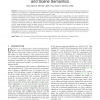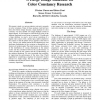134
Voted
PAMI
2012
13 years 3 months ago
2012
—We introduce an efficient maximum likelihood approach for one part of the color constancy problem: removing from an image the color cast caused by the spectral distribution of ...
121
click to vote
PAMI
2011
14 years 7 months ago
2011
—Existing color constancy methods are all based on specific assumptions such as the spatial and spectral characteristics of images. As a consequence, no algorithm can be conside...
140
Voted
CVPR
2011
IEEE
14 years 9 months ago
2011
IEEE
Color is known to be highly discriminative for many object recognition tasks, but is difficult to infer from uncontrolled images in which the illuminant is not known. Traditional...
106
Voted
ICPR
2010
IEEE
14 years 10 months ago
2010
IEEE
We address here the problem of color constancy and propose a new method to achieve color constancy based on the statistics of images with color cast. Images with color cast have st...
101
Voted
NN
2007
Springer
15 years 9 days ago
2007
Springer
A number of machine learning (ML) techniques have recently been proposed to solve color constancy problem in computer vision. Neural networks (NNs) and support vector regression (...
110
Voted
INFORMATICALT
2000
15 years 18 days ago
2000
Abstract. Color constancy is the perceived stability of the color of objects under different illuminants. Four-layer neural network for color constancy has been developed. It has s...
PRL
2006
15 years 22 days ago
2006
Objects retain their color in spite of changes in the wavelength and energy composition of the light they reflect. This phenomenon is called color constancy and plays an important ...
95
Voted
NIPS
2003
15 years 2 months ago
2003
We present a Bayesian approach to color constancy which utilizes a nonGaussian probabilistic model of the image formation process. The parameters of this model are estimated direc...
113
click to vote
IMAGING
2003
15 years 2 months ago
2003
We present a study on various statistics relevant to research on color constancy. Many of these analyses could not have been done before simply because a large database for color ...
119
Voted
IMAGING
2003
15 years 2 months ago
2003
Current color-printing technologies may use three or more inks, e.g., CMY, CMYK, CMYKcm, CMYKGO, CMYKRGB. When the number of inks exceeds three, there is the usual color-managemen...




